Confined space containers are specialized environments that pose unique challenges and risks, particularly in industries such as construction, manufacturing, and oil and gas. These spaces are often designed to be inaccessible or difficult to enter, which can make them hazardous for workers. This article delves into the intricacies of confined space containers, including their definitions, safety protocols, regulatory requirements, and best practices to ensure worker safety.

What Are Confined Space Containers?
A confined space container is an area that is large enough for a person to enter and perform work but has limited means of entry and exit. These spaces are not designed for continuous occupancy and often have poor ventilation, which can lead to the accumulation of hazardous substances. Examples of confined space containers include:

- Tanks and Vessels: Storage tanks, pressure vessels, and reaction chambers.
- Pipes and Ducts: Large pipes, ducts, and conduits.
- Pits and Sumps: Underground pits, sumps, and wells.
- Silos and Hoppers: Storage silos, hoppers, and bins.
- Boilers and Furnaces: Industrial boilers and furnaces.
Why Are Confined Space Containers Dangerous?
Confined space containers pose significant risks due to their unique characteristics. Some of the primary hazards include:
- Atmospheric Hazards: The accumulation of toxic gases, oxygen-deficient or oxygen-enriched atmospheres, and flammable or explosive gases.
- Physical Hazards: Engulfment, entrapment, and physical injuries from moving parts or falling objects.
- Environmental Hazards: Exposure to extreme temperatures, noise, and vibration.
Regulatory Requirements for Confined Space Containers
To mitigate the risks associated with confined space containers, various regulatory bodies have established stringent guidelines and standards. In the United States, the Occupational Safety and Health Administration (OSHA) provides comprehensive regulations under the Confined Spaces in Construction Standard (29 CFR 1926 Subpart AA) and the General Industry Standard (29 CFR 1910.146).
Key regulatory requirements include:
- Permit-Required Confined Spaces: Employers must identify and classify confined spaces as permit-required if they contain or have the potential to contain any recognized serious hazard.
- Permit System: A written permit system must be established, which includes procedures for preparing, issuing, and canceling permits.
- Training: Employees must receive training on the hazards of confined spaces and the procedures for safe entry.
- Hazard Assessment: Employers must conduct a hazard assessment to identify and evaluate the potential hazards of each confined space.
- Atmospheric Testing: Continuous monitoring of the atmosphere within the confined space is required to detect hazardous conditions.
- Rescue and Emergency Services: Employers must have a rescue and emergency plan in place, including the availability of trained rescue personnel and appropriate equipment.
Best Practices for Working in Confined Space Containers
To ensure the safety of workers in confined space containers, it is crucial to follow best practices and implement robust safety protocols. Some of these best practices include:
Pre-Entry Planning:
- Conduct a thorough pre-entry assessment to identify all potential hazards.
- Develop a detailed entry plan that includes all necessary safety measures.
- Ensure that all required permits are obtained and that all safety equipment is in place.
Training and Competency:
- Provide comprehensive training to all workers who will be entering confined spaces.
- Ensure that workers are competent in using safety equipment and following emergency procedures.
Atmospheric Monitoring:
- Use calibrated gas detectors to continuously monitor the atmosphere within the confined space.
- Ensure that the air quality is safe for breathing before and during entry.
Personal Protective Equipment (PPE):
- Provide appropriate PPE, such as respirators, protective clothing, and fall protection equipment.
- Ensure that PPE is properly maintained and inspected before use.
Communication and Supervision:
- Establish clear communication protocols between workers inside and outside the confined space.
- Assign a competent supervisor to oversee the entry and ensure that all safety procedures are followed.
Rescue and Emergency Procedures:
- Develop and practice a detailed rescue plan.
- Ensure that rescue personnel are trained and equipped to perform rescues in confined spaces.
- Have emergency medical services on standby if necessary.
FAQs About Confined Space Containers
Q: What is a permit-required confined space?A: A permit-required confined space is a space that contains or has the potential to contain any recognized serious hazard, such as atmospheric hazards, physical hazards, or environmental hazards. Employers must obtain a permit before allowing workers to enter these spaces.
Q: What are the most common hazards in confined space containers?A: The most common hazards in confined space containers include atmospheric hazards (toxic gases, oxygen-deficient or oxygen-enriched atmospheres), physical hazards (engulfment, entrapment), and environmental hazards (extreme temperatures, noise, and vibration).
Q: What is the role of atmospheric testing in confined space entry?A: Atmospheric testing is crucial to ensure that the air quality within the confined space is safe for breathing. Continuous monitoring using calibrated gas detectors helps detect hazardous conditions and prevent accidents.
Q: How often should workers receive training on confined space safety?A: Workers should receive initial training before their first entry into a confined space and refresher training at least annually. Additional training may be required if there are changes in the work environment or procedures.
Q: What are the consequences of non-compliance with confined space regulations?A: Non-compliance with confined space regulations can result in severe penalties, including fines, legal action, and damage to the company's reputation. More importantly, it can lead to serious injuries or fatalities, which can have long-lasting impacts on workers and their families.
Confined space containers are essential in many industries, but they also present significant risks to worker safety. By understanding the definitions, hazards, regulatory requirements, and best practices, employers and workers can mitigate these risks and ensure a safer working environment. Continuous training, thorough planning, and robust safety protocols are key to preventing accidents and protecting the well-being of all individuals involved in confined space operations.
By adhering to these guidelines, industries can create a culture of safety and compliance, ultimately leading to more productive and secure work environments.







